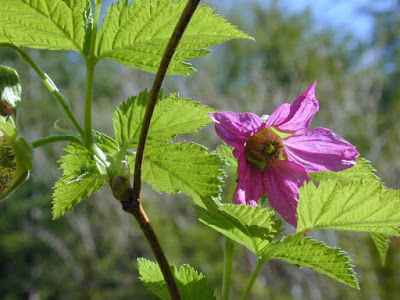Salmonberry.

I grew up eating salmonberries, as well as salal, and when lucky, huckleberries. Salmonberry (Rubus spectabilis), a member of the rose family (Rosaceae), is a deciduous shrub, with 3 leaflets, which flowers in early spring with berries are ripening by late spring - early summer, harvested til late July.The berries are a golden yellow which turn to orange then to red. It can grow to 12 feet, is perennial, and has thorns along the stems. The flowers have stamens in the centre of 5 pink petals. Indigenous people along the coast ate both the berries and the new shoots, with the new shoots being picked in spring, peeled, and eaten raw or steamed. Central and Northern First Nations ate them with Goolichan grease or dried salmon spawn; and all ate them with salmon. The berries were usually eaten fresh as they are quite watery and don't keep well. The Swainson's thrush is called the salmonberry bird in many languages, being associated with the ripening of the berr...
